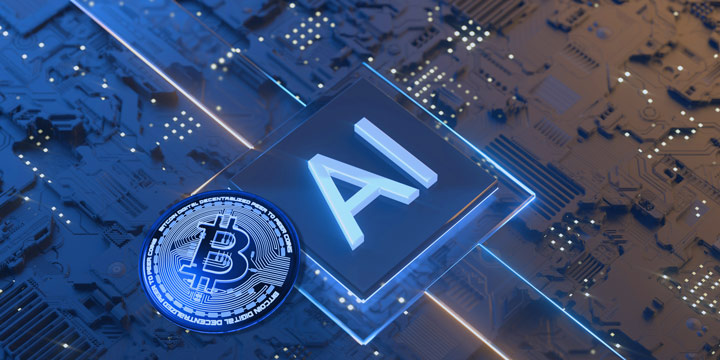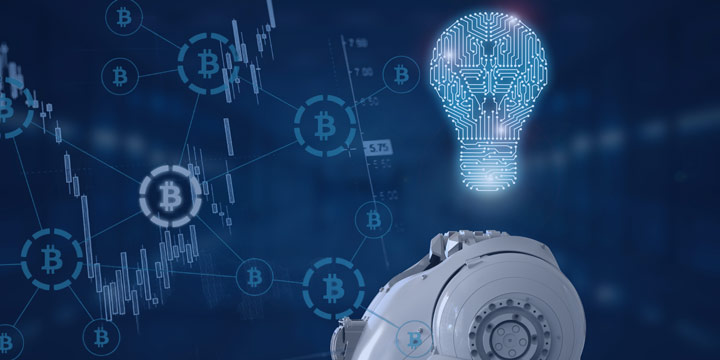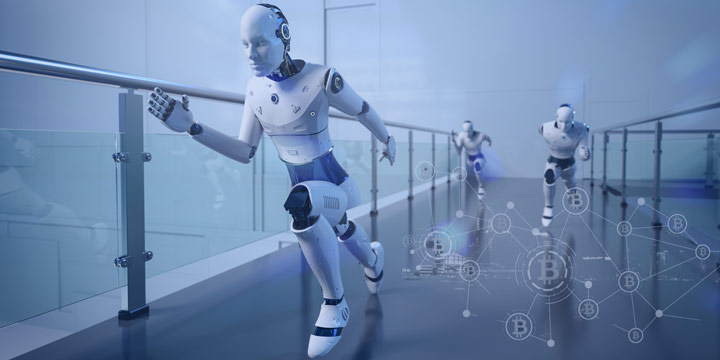The digital world has been buzzing with excitement since the launch of OpenAI’s ChatGPT. This exciting development has sparked global discussions and piqued interest in the realm of artificial intelligence (AI), a technology that, while not new, has been evolving and improving for decades.
From virtual assistants like Siri and Alexa to self-driving cars and medical diagnoses, AI has been improving our interactions with technology and holds the potential to shape our future in ways we’re still discovering.
Parallel to the AI revolution, blockchain technology and cryptocurrencies have been making their own waves. They’ve disrupted traditional finance, introduced new forms of digital assets, and reshaped payment systems. But what happens when these two transformative technologies converge? The fusion of crypto and AI promises to unlock a new world of possibilities.
This blog post will explore ways AI can be integrated into crypto, bringing many benefits. However, as with all emerging technologies, it’s not all smooth sailing. We’ll also discuss the challenges of these advancements and how we can navigate them.
So, whether you’re an AI enthusiast intrigued by the launch of ChatGPT, a crypto enthusiast, or just someone curious about these technologies, join us on this enlightening journey. It’s a ride into the future you won’t want to miss!
The Fusion of Blockchain Technology and Artificial Intelligence: A Mixed Bag of Opportunities and Hurdles

When we talk about the digital revolution, two technologies often take center stage: blockchain and artificial intelligence (AI). Each has its own set of unique capabilities.
But do they have anything in common?
For one, they both have many use cases and are leading today’s tech trends and innovation but are otherwise different.
With its decentralized nature, blockchain acts as transparent, tamper-proof storage. AI is an opaque, centralized processor of massive amounts of data. While AI struggles with privacy and transparency, blockchain struggles with efficiency and scalability, making them a perfect match able to address each other’s weaknesses.
The fusion of AI and blockchain technology is like a meeting of minds, opening up a world of opportunities. For instance, AI can enhance the security measures of blockchain networks, making crypto transactions even more secure. It can also improve the efficiency of crypto trading by using machine learning algorithms to predict market trends.
Blockchain has given birth to a new form of finance, enabling secure and transparent transactions in the crypto space. On the other hand, AI, with its immense computing power, can analyze vast amounts of data, making our devices smarter and our lives easier.
However, this integration isn’t all sunshine and rainbows. It comes with its own set of challenges. The decentralized nature of blockchain can make it difficult to implement AI solutions, as AI often requires centralized data. Additionally, the energy demands of these two technologies can be high, posing environmental concerns.
Despite these hurdles, the potential benefits of integrating AI and blockchain are immense. And that’s exactly what we’ll look into in the next sections. We’ll explore the bright side of this fusion, the hurdles we need to overcome, and how we can navigate this exciting yet complex terrain. So, stay with us as we journey into the heart of crypto and AI convergence.
Benefits: The Bright Side of Crypto and AI Integration

The fusion of artificial intelligence (AI) and crypto is like a match made in digital heaven, bringing together the best of both worlds. Integrating these two technologies can unlock many benefits that can transform our digital economy. Here are some of the key advantages:
Boosting Efficiency
One of the most exciting benefits of merging AI with the crypto world is the potential for improved efficiency. AI has the power to automate a multitude of tasks and decision-making processes in web3 applications.
This automation not only speeds things up but also reduces the chance of human error, leading to a more productive and streamlined crypto space.
Supercharging Analytics and Insights
Let’s face it, the amount of data available on- and off-chain can be overwhelming. Analyzing this vast ocean of information is a time-consuming task. But guess what? AI comes to the rescue!
Integrating artificial intelligence (AI) can lead to more accurate and insightful data analysis.
Revolutionizing Risk Management
Risk management is a crucial aspect of any financial endeavor, and the crypto market is no exception. AI can play a pivotal role in enhancing risk management processes.
From aiding in auditing smart contracts to automating risk monitoring in trading, artificial intelligence can help identify potential red flags early on. This proactive approach can significantly improve the security and reliability of crypto transactions.
Challenges: The Hurdles We Need to Overcome in the Crypto and AI Journey

The journey of integrating crypto and AI is an exciting one, filled with immense potential. However, like any voyage into uncharted territories, it comes with its challenges. Here are some of the key obstacles we need to navigate:
Scaling the Adoption Mountain
While AI-powered crypto dApps and blockchain platforms have started to gain traction, their adoption is still limited to a small group of users. This integration is relatively young, and driving more use cases will be key to increasing adoption. The key to scaling this mountain lies in showcasing real-world use cases that solve tangible problems for users.
Crossing the Bridge from Concept to Utility
Many projects are actively developing in this field, looking to integrate artificial intelligence. However, several of these projects are still in the proof-of-concept stage. It’s crucial to move beyond the drawing board and develop usable products that fit the market needs. This is key to driving the adoption and growth of this space.
Solving the Privacy Puzzle
With the reliance on vast amounts of data, privacy becomes a significant concern. It’s a puzzle that needs solving, especially regarding how data is used and secured. The solution is crafting robust data protection, usage, and security policies that respect user privacy while enabling innovation.
Tackling the Technical Challenges
Integrating AI and blockchain technology is a complex process requiring a unique blend of expertise. It’s like untangling a knot that requires patience, skill, and a deep understanding of both technologies. Developing common standards and promoting research in these fields will be crucial in tackling this technical tangle.
Exploring the Potential: Use Cases and Future Possibilities of Crypto and AI Integration

The fusion of crypto and AI is not just a theoretical concept; it’s already transforming various sectors, offering innovative solutions, and creating new opportunities. Here are some exciting possibilities this integration brings to the table.
Fraud Detection and Prevention
When it comes to payment, security is paramount. With its ability to analyze vast amounts of transaction data in real-time, AI acts as a vigilant guard. It identifies patterns and anomalies that could indicate fraudulent activity, enhancing the security of crypto transactions and bolstering consumer trust in digital crypto payment methods.
Automation and Efficiency Streamlined Transactions
The fusion of crypto and AI is transforming the payment landscape, ushering in a new era of smarter, safer, and more personalized transactions. With AI-powered systems, manual and time-consuming tasks like data entry and verification can be automated, significantly reducing the time it takes to complete a transaction.
Blockchain network eliminates the need for a third party in transactions, speeding up the process and increasing efficiency. For instance, decentralized exchanges built on blockchain technology allow for direct asset exchanges, with all transactions recorded on the blockchain for transparency and auditability.
On the other hand, artificial intelligence can automate the evaluation of these transactions, making the process scalable as data increases exponentially. This combination of AI and blockchain technology in payments is not only efficient but also secure and transparent.
Expanding Financial Inclusion
Crypto and AI are breaking down barriers to financial inclusion. With AI’s ability to verify user identities and blockchain’s secure and transparent nature, financial services are becoming more accessible, even in areas with limited infrastructure. This is particularly significant in developing regions where traditional banking services are often out of reach.
Personalized Customer Experiences
AI’s ability to analyze and learn from data is improving customer experiences. By examining a user’s transaction history and other relevant data, AI can help crypto platforms offer personalized services, such as targeted offers, rewards, or discounts. This enhances the user experience, increases customer loyalty, and drives higher sales.
Predictive Analytics in DeFi
Predictive analytics uses data, statistical algorithms, and machine learning techniques to identify the likelihood of future outcomes and forecast trends. When paired with AI, predictive analytics can help analyze large amounts of on-chain data to predict token price movements and automate subsequent trading decisions.
Ocean Protocol is an example of a project that uses AI and predictive analytics to unlock the value of data and enable data sharing and monetization. They constantly run rounds of the Predict-ETH challenge, where participants use AI modeling approaches and data feeds to predict the price of the ETH coin.
Generative NFTs
AI is also making its mark in the world of NFTs. Several NFT projects use AI to create generative art through an autonomous system. The AI can generate unique art pieces by inputting a set of rules or constraints.
Art Blocks, for instance, is a platform that uses AI to create and mint unique pieces of generative art as NFTs.
Intelligent NFTs (iNFTs)
Going a step further, some projects are integrating AI with NFTs to create intelligent NFTs (iNFTs) that can interact with users. These iNFTs can analyze data to learn and evolve their personality based on real-time interactions. This could have profound implications for web3 gaming and the future of the metaverse, where in-game characters are significantly more interactive, and conversations become more life-like.
Alethea AI is creating intelligent NFTs (iNFTs) to communicate and interact with their owners. They’re leveraging AI to give NFTs a ‘life’ of their own.
Cryptocurrency for AI Agents
As AI bots become more advanced, they could function as personal assistants, performing routine tasks involving payments or economic exchange by utilizing the on-chain financial stack of the Web3 industry. This would eliminate the need for intermediaries and an opaque, paper-based financial system.
Enhancing the Metaverse Experience
AI can significantly improve user experiences in virtual worlds by creating a more interactive and immersive environment. AI-enabled non-playing characters (NPCs) can act as chatbots to engage and communicate with players in a more realistic manner. Additionally, AI can create life-like digital avatars that mimic physical traits and movements.
Decentraland, a virtual reality platform built on the Ethereum blockchain, is one example of a project using AI to enhance the metaverse experience. The SophiaVerse has opened in the pioneering metaverse ecosystem of Decentraland.
AI-powered DAO Central Smart Contract
DAOs, or Decentralized Autonomous Organizations, are entities governed by smart contracts and the consensus of their members. They have the potential to revolutionize the way organizations are run, making them more democratic, transparent, and efficient. However, running a DAO can be operationally challenging and involves many tedious tasks.
The integration of AI can significantly enhance the functionality of DAOs. The central smart contract of a DAO, which serves as its technical backbone, can be powered by AI. This AI-powered central smart contract can consume resources devoted to it by human token holders and autonomously make decisions. This reduces the operational burden on DAO members and allows the DAO to operate more efficiently and effectively.
An example of this is SingularityDAO, a DAO on SingularityNET that uses AI to autonomously allocate assets and manage the portfolios of token holders. SingularityDAO leverages Machine Learning and Neural Networks for strategies, signals, and automated trading algorithms. This allows it to optimize portfolios and provide data-driven market predictions, enhancing the value it provides to its token holders.
Wrapping Up
As we delve into the potential of crypto and AI integration, it’s important to remember that while the concept is exciting and full of promise, it’s still in its early stages. The adoption of AI in the crypto ecosystem is not yet widespread, suggesting that while these technologies offer intriguing possibilities, they may not be essential to the industry’s current state.
However, emerging technologies often take time to mature and find their footing. As crypto and AI continue to evolve, we expect to see more refined and effective use cases that can benefit various stakeholders in the ecosystem. The journey may be filled with challenges and learning curves, but the potential rewards make it worthwhile.
In the meantime, CoinPayments is committed to staying at the forefront of these advancements, providing our users with the most secure, efficient, and innovative crypto-payment solutions. As we continue to explore, innovate, and push the boundaries of what’s possible with crypto and AI, we invite you to join us on this exciting journey.
Ready to experience the future of crypto payments? Start using CoinPayments today and be a part of the revolution. Sign up now and take your crypto transactions to the next level.




